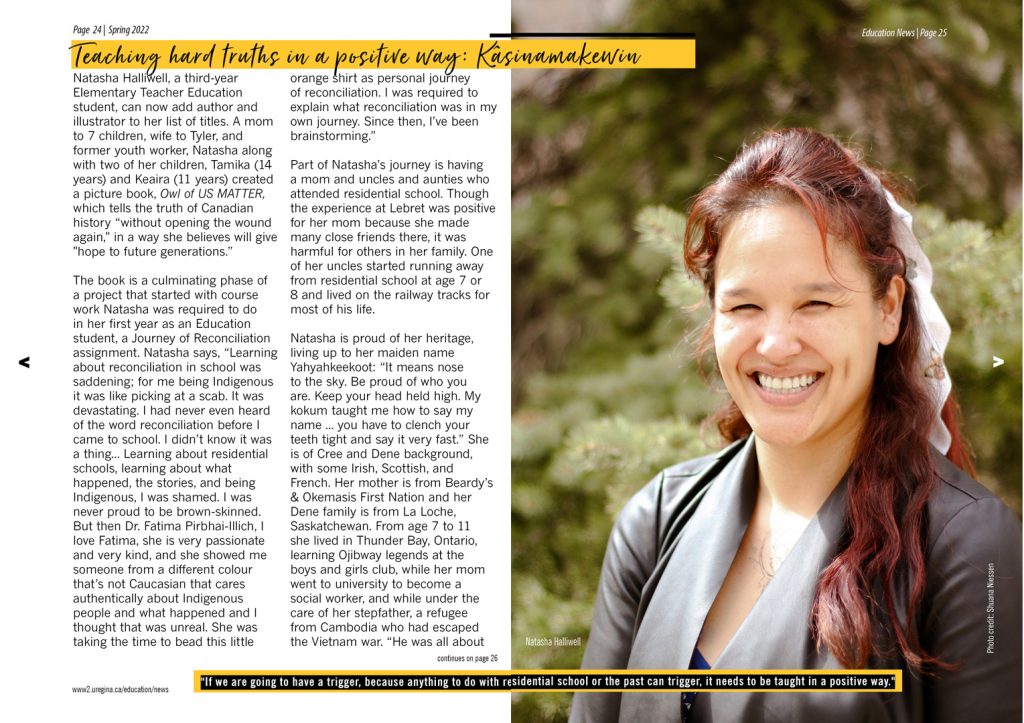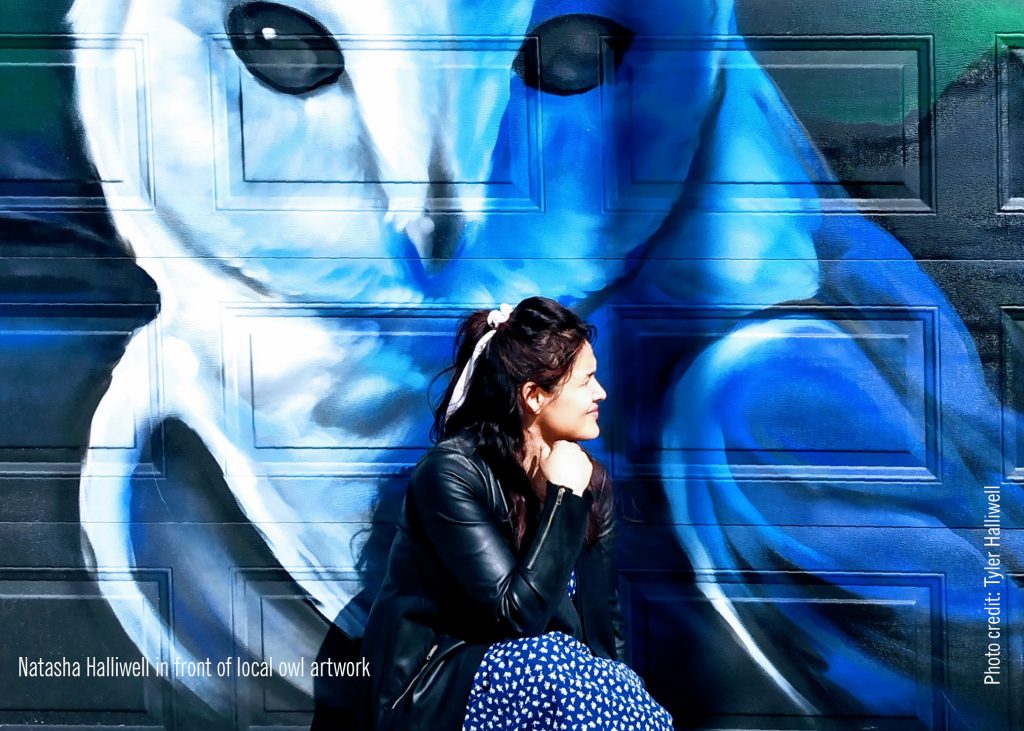 Natasha Halliwell, a third-year Elementary Teacher Education student, can now add author and illustrator to her list of titles. A mom to 7 children, wife to Tyler, and former youth worker, Natasha along with two of her children, Tamika (14 years) and Keaira (11 years) created a picture book, Owl of US MATTER, which tells the truth of Canadian history “without opening the wound again,” in a way she believes will give “hope to future generations.”
Natasha Halliwell, a third-year Elementary Teacher Education student, can now add author and illustrator to her list of titles. A mom to 7 children, wife to Tyler, and former youth worker, Natasha along with two of her children, Tamika (14 years) and Keaira (11 years) created a picture book, Owl of US MATTER, which tells the truth of Canadian history “without opening the wound again,” in a way she believes will give “hope to future generations.”
The book is a culminating phase of a project that started with course work Natasha was required to do in her first year as an Education student, a Journey of Reconciliation assignment. Natasha says, “Learning about reconciliation in school was saddening; for me being Indigenous it was like picking at a scab. It was devastating. I had never even heard of the word reconciliation before I came to school. I didn’t know it was a thing… Learning about residential schools, learning about what happened, the stories, and being Indigenous, I was shamed. I was never proud to be brown-skinned. But then Dr. Fatima Pirbhai-Illich, I love Fatima, she is very passionate and very kind, and she showed me someone from a different colour that’s not Caucasian that cares authentically about Indigenous people and what happened and I thought that was unreal. She was taking the time to bead this little orange shirt as personal journey of reconciliation. I was required to explain what reconciliation was in my own journey. Since then, I’ve been brainstorming.”
Part of Natasha’s journey is having a mom and uncles and aunties who attended residential school. Though the experience at Lebret was positive for her mom because she made many close friends there, it was harmful for others in her family. One of her uncles started running away from residential school at age 7 or 8 and lived on the railway tracks for most of his life.
Natasha is proud of her heritage, living up to her maiden name Yahyahkeekoot: “It means nose to the sky. Be proud of who you are. Keep your head held high. My kokum taught me how to say my name … you have to clench your teeth tight and say it very fast.” She is of Cree and Dene background, with some Irish, Scottish, and French. Her mother is from Beardy’s & Okemasis First Nation and her Dene family is from La Loche, Saskatchewan. From age 7 to 11 she lived in Thunder Bay, Ontario, learning Ojibway legends at the boys and girls club, while her mom went to university to become a social worker, and while under the care of her stepfather, a refugee from Cambodia who had escaped the Vietnam war. “He was all about outdoors and survival. He taught me how to fight and survival skills. I grew up wonderfully like that,” says Natasha.
When her mom and siblings moved back to Saskatchewan, Natasha found another influence in her life: her uncle Leo Yahyahkeekoot, a Cree culture teacher in Saskatoon.
Natasha says, “My Uncle Leo really impacted me, just the way you can teach. Even though we all have our negative sides to this history, we can reroute it to the positive. Yeah it did happen, and it’s not going anywhere; it’s almost like we ain’t there, we’re in a shadow, that’s where I felt I was shamed. We need to help each other to make it okay. We all have our dark history, but it doesn’t mean we can’t forgive.”
After learning about Post Traumatic Stress Disorder (PTSD), Natasha was concerned about the way triggering information is taught: “I learned about PTSD. And I started going through it, and I’m like, this happened to me. Okay, this is my family. And I started understanding my life a little bit more. And caring. And then I think because I learned about it through school, I’m able to spot things that are triggers. If we are going to have a trigger, because anything to do with residential school or the past can trigger, it needs to be taught in a positive way.”
“Kâsinamakewin – time to forgive” is the message of Natasha’s book that she hopes will make teaching the hard truths of our shared history less triggering and more positive. “You have to let something go for something new to come. Forgiveness. Putting us all on that equal playing field. It wasn’t only us that had something taken, and had that change, it was everybody. It was every living thing, including the sacred grandfather rocks, for instance. This book will teach the truth equally. It’s easy to comprehend. Easy to read and talk about,” says Natasha.
Natasha didn’t know what to do with her 2-year curriculum project until she conceived of a picture book through another class: “I had this class with Denise Morstad, and my personal art project, the whole thing just took off.” The book is designed to connect to the Saskatchewan curriculum. Natasha says, “My book connects outcomes in the Saskatchewan curriculum for every grade. Plus I have my teaching resources. It’s a big thing all in one.”
For the illustrations, Natasha and her daughters recreated many historical images using owls. Owls were an unusual choice, given they are a bad omen for First Nations. Natasha explains, “I wanted to get rid of race, the separation, the blame. I thought about the owl. An owl has many species that look the same but are different. So I used owls as characters. I use to hate owls; some are associated with death for First Nations. But my daughters love owls. Tamika loves the great horned owl, and Keaira loves the snowy barn owl.”
“I never thought I cared about residential schools, reconciliation, or being Native until I started going to university. I use to hate being brown. I was ashamed, it’s hard being brown. Even coming here sometimes, because you are the only brown girl in class, and then you see the odd one and you get really excited. I was constantly reminded of my difference, and that’s what really brought me to my book,” says Natasha.
Natasha hopes to ease the path for her children and future generations to have a more positive healing experience with education on reconciliation and residential schools.
“I don’t want my kids to feel that shame. They have friends who are Pakistani, Black, you name it. They come to their birthdays. We order so many different kinds of food. It’s so multicultural. I don’t want that diversity to die. I want kids to be able to have that without feeling that shame or separation because of an old fact in history. And well, yeah, there are things that need to be made right in terms of compensation and the Queen, but those things will get dealt with once more people are educated. Right now it’s almost a forgotten truth. It’s a hard truth to swallow. That’s why I needed my book. How am I going to be a teacher if I’m going to pull out all of these facts that I’ve learned? I wanted to compact that and make a friendly little version. ‘This happened, it’s done now. Let’s move on.’ I made sure a lot of facts and information in the book, but at a really easy learning level,” says Natasha.
An invitation to read her book to a class of students has already been extended to Natasha, and she has accepted. She looks forward to future opportunities.
You can view and purchase Natasha’s book at https://www.blurb.com/b/11160722-owl-of-us-matter
A Cree version is now available (Translated by Solomon Ratt) https://www.blurb.com/b/11181079-owl-of-us-matter-cree-version
Follow us on social media